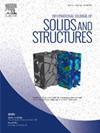利用人工神经网络建立微空洞和构成性损伤模型
IF 3.8
3区 工程技术
Q1 MECHANICS
International Journal of Solids and Structures
Pub Date : 2024-10-30
DOI:10.1016/j.ijsolstr.2024.113125
引用次数: 0
摘要
多孔介质的连续介质模型彻底改变了传统韧性材料的计算断裂力学,但其固有假设对其他目标材料或加载条件的通用性有限。在此,我们采用一系列人工神经网络(ANN)来预测多孔弹塑性材料在各种变形状态下的微观空隙特征(空隙形状、孔隙率)和宏观应力应变构成响应。我们在三维代表性体积元素(RVE)的有限元模型生成的数据集上训练 ANNs,每个模型都包含一个离散的球形空隙,并受到加载状态组合的影响。结果表明,数据驱动模型能够对训练数据集之外的各种初始孔隙率(0-20%)和加载状态进行内推预测和一定程度的外推预测,即使在高变形应变导致材料软化和空隙增长的情况下也是如此。通过迁移学习,我们进一步证明,最初在特定多孔材料数据集上训练的方差网络,可以通过大幅减少训练数据集,很容易地适用于性质大相径庭的其他多孔材料。我们讨论了这种机器学习方法与广泛开发的 Gurson 模型相比对多孔材料损伤和失效预测的影响。本文章由计算机程序翻译,如有差异,请以英文原文为准。
Microvoiding and constitutive damage modeling with artificial neural networks
Continuum models of porous media have revolutionized computational fracture mechanics for traditional ductile materials, but the inherent assumptions have limited generalizability to other target materials or loading conditions. Here, we adopt a series of artificial neural networks (ANNs) to predict both the microscopic voiding characteristics (void shape, porosity) and macroscopic stress–strain constitutive response of porous elasto-plastic materials under various deformation states. We train the ANNs on a dataset generated from finite element models of 3D representative volume elements (RVEs), each containing a discrete spherical void, subjected to combinations of loading states. Results show that the data-driven model is capable of interpolative predictions as well as some levels of extrapolative predictions across a wide range of initial porosities (0–20%) and loading states outside of the training dataset, even at high deformation strains which induce extensive material softening and void growth. Through transfer learning, we further demonstrate that the ANNs, originally trained on a specific porous material dataset, can be readily adapted to other porous materials with substantially different properties through a significantly reduced training dataset. We discuss the implications of this machine learning approach vis-à-vis the extensively-developed Gurson model for porous material damage and failure predictions.
求助全文
通过发布文献求助,成功后即可免费获取论文全文。
去求助
来源期刊
CiteScore
6.70
自引率
8.30%
发文量
405
审稿时长
70 days
期刊介绍:
The International Journal of Solids and Structures has as its objective the publication and dissemination of original research in Mechanics of Solids and Structures as a field of Applied Science and Engineering. It fosters thus the exchange of ideas among workers in different parts of the world and also among workers who emphasize different aspects of the foundations and applications of the field.
Standing as it does at the cross-roads of Materials Science, Life Sciences, Mathematics, Physics and Engineering Design, the Mechanics of Solids and Structures is experiencing considerable growth as a result of recent technological advances. The Journal, by providing an international medium of communication, is encouraging this growth and is encompassing all aspects of the field from the more classical problems of structural analysis to mechanics of solids continually interacting with other media and including fracture, flow, wave propagation, heat transfer, thermal effects in solids, optimum design methods, model analysis, structural topology and numerical techniques. Interest extends to both inorganic and organic solids and structures.

 求助内容:
求助内容: 应助结果提醒方式:
应助结果提醒方式:


